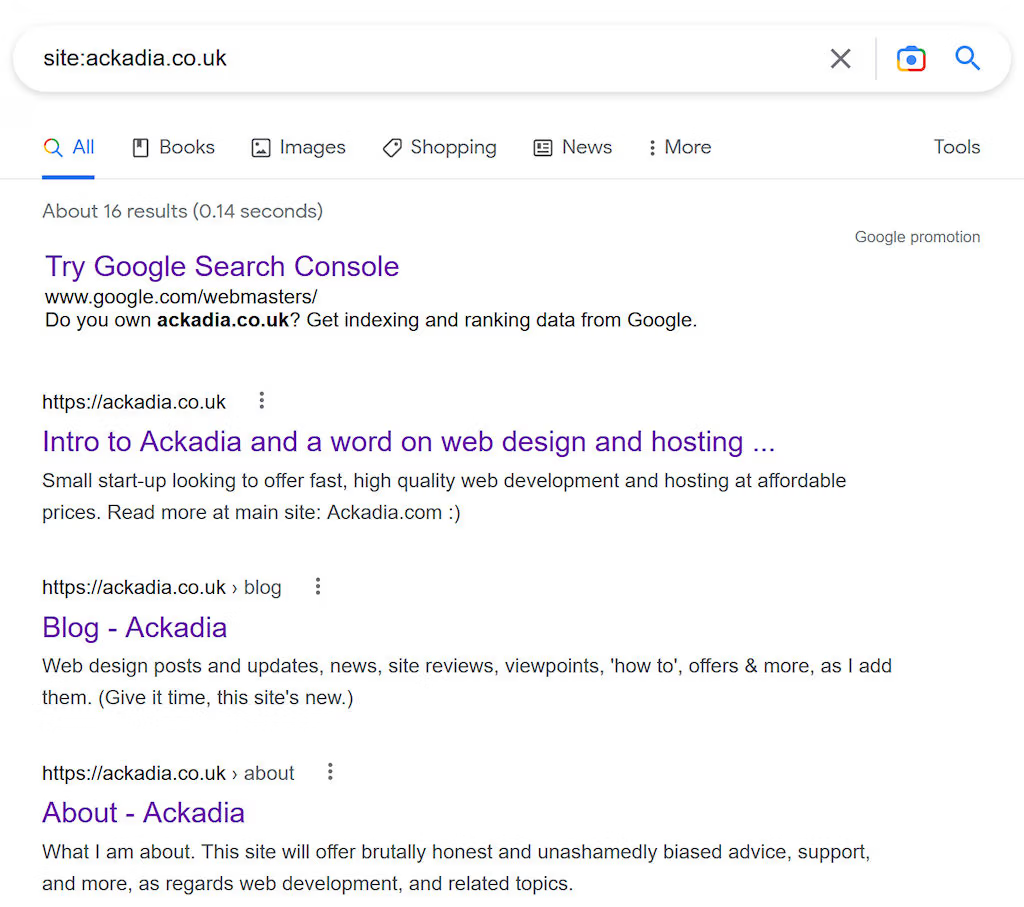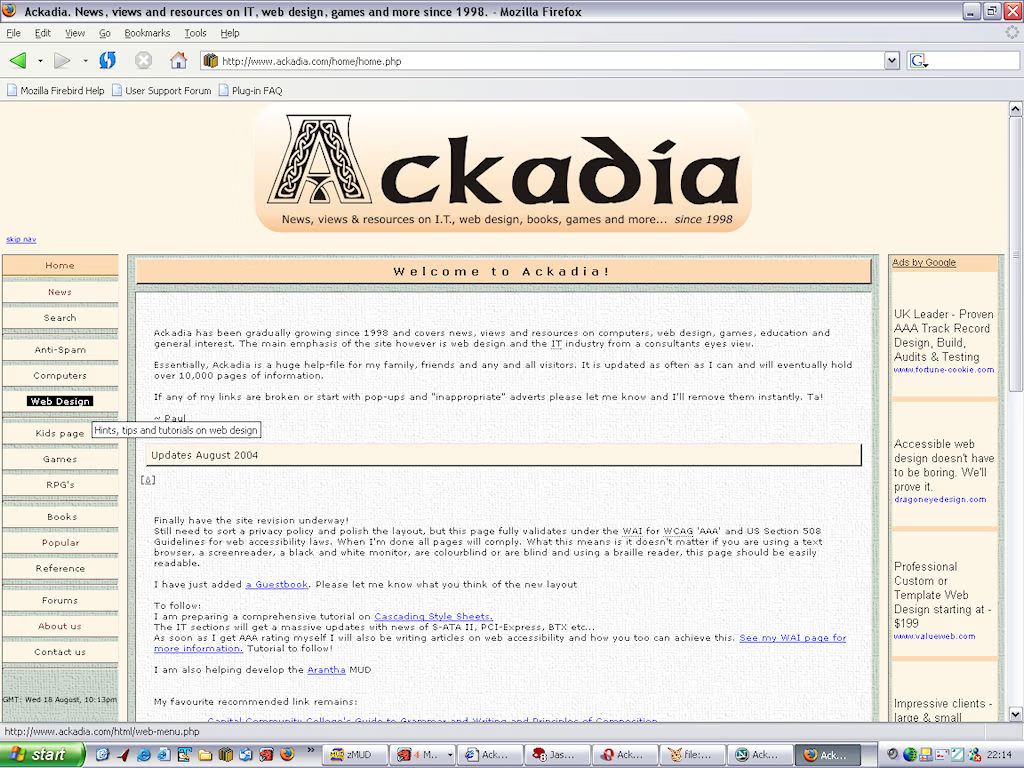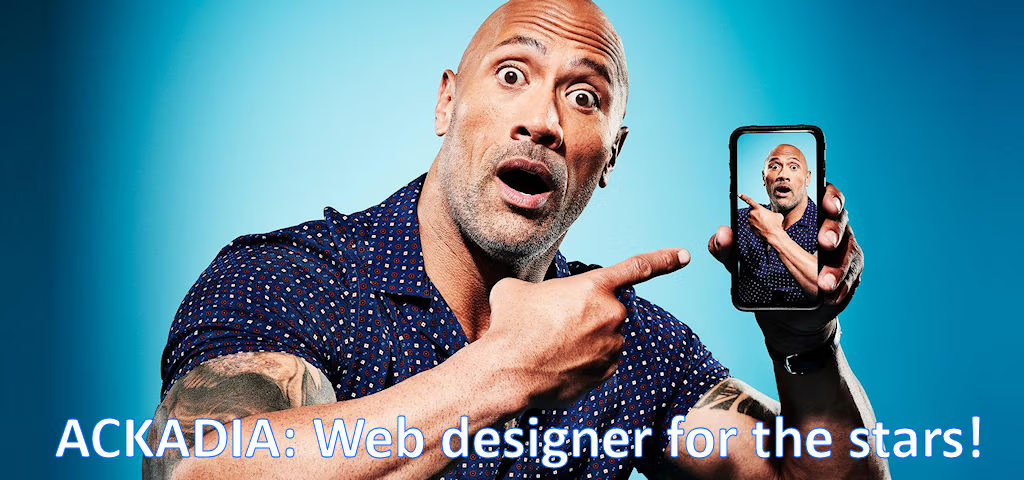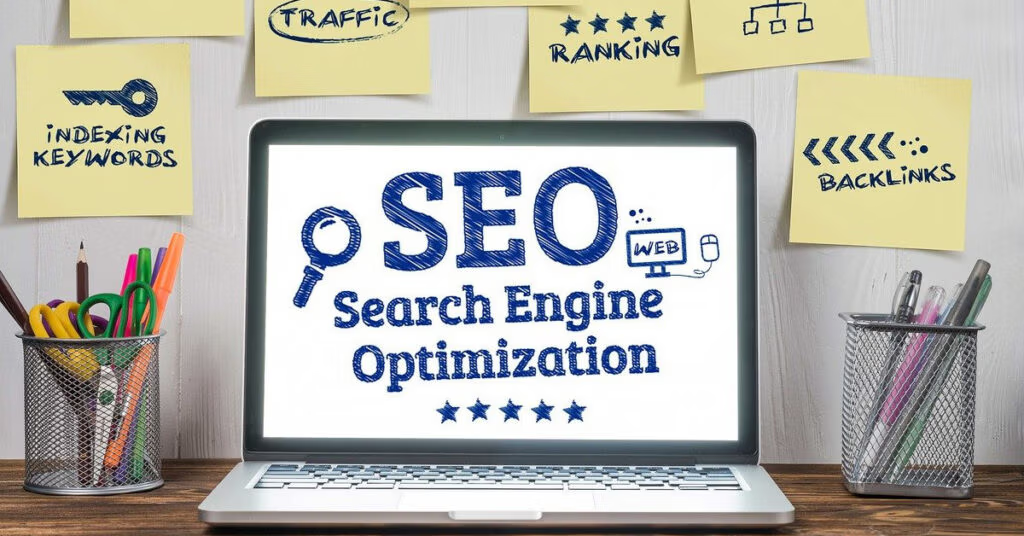SEO is just about common sense
Alas, as Franois-Marie Arouet (aka Voltaire) famously said, “Common sense is not so common.”
I’m not selling myself as an expert here; I don’t, for instance, enthuse about keywords. However, I’ve been around at least as long as Google. I watched them start, grow, evolve, and change (not always for the better). I have noticed over these past twenty years how they think, react, and what matters to them (besides money). Albeit with wildly different end goals, their actions make sense to me, and I understand how they think. Or at least I like to believe so. Read on.
Google, the early days
As far as I can tell, Google’s early thinking for search engines went like this
“How can we gain market share (without spending money)?”
The answer was Adsense, in the form of customisable javascript that web developers could size, colour, shape and selectively place on their sites.
If you are interested, this is an example of their embeddable Adsense code back in 2004:
<script type=”text/javascript”>
google_ad_client = “pub-12345678901234567”;
google_ad_width = 120;
google_ad_height = 600;
google_ad_format = “120x600_as”;
google_ad_channel =””;
google_color_border = “CCCCCC”;
google_color_bg = “FDEFD2”;
google_color_link = “000000”;
google_color_url = “0000FF”;
google_color_text = “000000”;
</script>
<script type=”text/javascript” src=”http://pagead2.googlesyndication.com/pagead/show_ads.js”></script>
<noscript>Google adverts</noscript>
It allowed you to potentially earn money from this. A LOT of money, it turned out.
Common sense says anything humans can exploit will be exploited before your back is even turned.
And so click fraud became big business, to Google’s eternal chagrin.
What quickly followed is large numbers of advertisers realising that not only are they not getting a return on their investment, they were being ripped off wholesale, and not in the cents per click we get now. Some high-paying terms were earning fraudsters (and costing advertisers) over $100 a click. Can’t remember the list offhand, but they included certain drugs and legal terms relating to claims.
This is only my interpretation, but the backlash went something like this:
Advertisers told Google, “Fix this. Or else.”
Google realised, “We are paying them (web designers) too much” and, having quickly grown in market share, turned on the web developers, changed the agreements and dramatically reduced payments/revenue share.
(i.e., If we are hurting, you can hurt too!)
Google followed this up with code changes and the now well-established frequent updates.
Fast forward to the middle years
As Google grew in size, profits and market share, it sought increasingly to cement that dominant position. This meant giving good results, which meant weeding out the junk as best as possible.
If you are interested, Search Engine Journal (SEJ) have a page dedicated to Google Algorithms, detailing famous (and infamous!) updates with names like Panda, Penguin and Hummingbird.
No one (possibly even Google itself!) knows all the rules in play; there are too many, they change and evolve, and they are mostly a secret. Valuations vary, but if you assume the SEO market is worth $100 billion a year and growing, you get an idea of the value of these secrets. So SEO experts guess. Educated guesses backed by experience, experimentation and roundtables, but guessing all the same.
And if Google thinks people are getting too close to the mark, they throw a spanner into the machine and the people trying to game the system fall down a hole.
Common sense will tell you not to try to game Google.
Google today
Google’s position is such that googling entered the dictionary as a verb and became ubiquitous. You no longer “do a web search”. Instead, you google.
Just how dominant is Google for search in 2022? (October)
According to many sources, notably statcounter:
Google controls a staggering 92.3% of the market.
Microsoft’s Bing is clinging onto flotsam with a mere 3.6%.
Yahoo is paddling behind at 1.3%, water going over its head.
Yandex (covering Russia) is 0.8%
Baidu (covering China’s 1.4 billion surfers) is only put at 0.6% share.
That leaves 1.4% for Duck Duck Go, Ecosia and all the rest, none of which have enough market share to register.
The takeaway from this is if Google makes a suggestion, it is not a suggestion.
Mostly Google doesn’t give clues. That is unless they want to change how the Internet works. You may assume such changes will be to make it easier to give reliable results (and, by extension, improve their profits).
(I don’t particularly like Google, but while I may sound negative and cynical, I understand them and agree with their choices).
One such recommendation was to have SSL for all sites (i.e. not just eCommerce).
The day Googled announced HTTPS as a ranking factor, I added SSL to my servers. It wasn’t free back then or cheap, but if they tell you to do something and you are a web developer, you do it. Plus, I am paranoid about security anyway, so was 100% for it. These days it is free, and even premium certificates are modestly priced, whereas there used to be eye-wateringly expensive. By 2018 Google took the gloves off and – never mind ranking – Chrome was telling people to back away from insecure sites.
As SEJ said at the time, Google Sets Deadline for HTTPS and Warns Publishers to Upgrade Soon.
Now all browsers issue a stark warning over insecure sites, e.g.:
Warning: Potential Security Risk Ahead
If you visit this site, attackers could try to steal information like your passwords, emails, or credit card details.
And yet you still see insecure sites all the time, see and hear of unscrupulous web designers asking silly amounts of money to secure sites they made and should have secured perhaps a decade ago!
Another suggestion is to improve your core metrics. How much this affects your ranking is up to debate, but there is no question that it massively affects your traffic, or at least your bounce rate. The recommendation is that your site or page load in under a second on desktop and under 2 seconds on mobile. Most sites fail miserably. Every second added, even a tenth of a second added, negatively affects your site.
Common sense tells you most people dislike queuing and do not like waiting in line. Web users are far less tolerable and by three seconds are done waiting and will increasingly look elsewhere for answers.
Time to eat!
By eat, I mean E-A-T: Expertise, Authoritativeness and Trustworthiness
E-A-T is a core part of our metrics and it stands for expertise, authoritativeness and trustworthiness. This has not always been there in Google, and it is something we have developed about 10 to 12 to 13 years ago. And it is really there to make sure that, along the lines of what we talked about earlier, that is it really there to ensure the content that people consume is going to be, is not going to be harmful and it is going to be useful to the user. These are principles we live by every single day.
Hyung-Jin Kim, the VP of Google Search, in a recent interview, quoted here:Google: E-A-T Applies To Every Single Query
My take on good SEO: meta
One failing I am guilty of and have been for years is metadata.
To be fair, when I started, you hand-coded everything. I had an Internet cafe (of sorts) back when the Internet only had around 23,500 websites in total. (Now, 10x that number are created every day). Altavista was the go-to place for searching, though several other web crawlers soon appeared. It would be years before Google appeared. A decade before CMS like WordPress started to become popular, and half as long again before tools like Yoast appeared.
Even as early as 2003, I wrote about using meta tag keywords for search engine optimisation. But when you are copying across and editing thousands of pages (and excluding the headers), stuff gets missed.
Using Yoast (or similar plug-ins) and filling in the metadata matter hugely. Not so much to your ranking but to whether people click on the link from the search engine to your page – or not. It gives you a little more control of the narrative.
Another widely accepted rule is to keep it fresh
This is covered under the recent caffeine update. SEJ detail it here: Google Freshness Algorithm: Everything You Need To Know
I would flag this as correct, misunderstood or misleading, and plain wrong, depending on how you interpret the suggestion.
I have long argued that you need to keep your site fresh, keep it up to date, and keep adding to it, so for me, Google took 20 years to see common sense!
Anyway, there are three ways of looking at this freshness.
The first is the caffeine update version, which focuses on timely, immediately relevant news.
1. Fresh coffee:
If a UFO suddenly lands in your garden and three greys step out saying, “We come in peace”, that is NEWS. If you and your neighbours start to post about it, Google will know within minutes. The world will know within an hour.
Google have a stack of rules ready for this:
Where did we find it first; who wrote about it first?
How trustworthy are they?
Which (trustworthy) news source picked up on it first?
It is a hoax?
Let’s assume it’s real, and the greys left their probes on the spaceship. Within hours the Internet will flood with posts about how aliens abducted them and how “aliens probed me!” Most of them will be monetised on sites created an hour earlier! Any ‘evidence’ will be a mashup of images and clips scraped from Alien, Resident Alien, I married an Alien, all the way down to Loony Toons’ Marvin the Martian.
For this story, E-A-T and caffeine core rules have already started culling fake posts. And blacklisting sites.
Do not make work for Google. They almost certainly have a rule or three to deal with troublemakers.
A variation of this freshness relates to cyclic events. If you only write about the Superbowl and have done for the past twenty years, you may be considered something of an authority, or at least a place to keep track of when the next Superbowl is coming up. The same could apply to your village’s monthly coverage of a taster if it were popular enough.
2. Granular coffee
This is what I (and Google) consider fresh content, but not in a timely sense. As an example, this post I am writing now. Some parts of it may be considered timely but are not newsworthy; the post is otherwise generic in that it writes about search engine optimisation in the wider sense.
However, it is fresh content here, so Google will likely notice it.
This, in turn, triggers several or even scores of rules.
Is it relevant to us at Google?
Is it relevant and appropriate (in keeping with) this site?
Is it mentioned on social media?
Has anyone linked to it yet; if so, are they trustworthy?
How are the internal links?
What external links are there?
If there are external links, are they affiliate or sponsored links? If so, are they flagged as such?
(If so, do they interfere with our advertising?) (I suspect 😉 )
and do forth
All this – and all of Google – essentially high-five the academic version of PROMPT*, which asks, “It this trustworthy?” (And then wants 100 citations to show it is ![]() )
)
*(Link downloads pdf from Open University)
PEEL is another: make your Point, Explain it, provide Evidence and Link it back
The business version is SMART: Specific, Measurable, Achievable, Relevant, and Time-Bound.
There are plenty of other acronyms, but they all agree one thing: Keep it real
Presentation:
For Google, this will include rules on page speed, accessibility, and grammar.
You might not think it matters, but it does. For weeks I was seeing an advert for “proffessional legal services”. How can you possibly trust a lawyer that can’t even spell ‘professional’?
Funnily enough – 100% true story – many years ago, I was at a trade show. One largely sponsored by Microsoft, promoting their new range of business software. (This was just after we (technies) had to deal with the fallout from Windows ME).
“Any questions?” asked the senior manager.
I put my hand up; my friend whispered, “please don’t, he’ll remember you from last year!”
Me: “How can we trust this product after ME?”
He coughed, squirmed and said, “Our products are thoroughly tested.”
I waved my complimentary package at him, the A0 wall posters around the marquee, and the vast screen behind him.
“So, there will be no problems with your new Professional range?”
(My colleague was trying to crawl away by now).
Manager: “As I said, we have complete confidence in this range”
Me, waving at the room in general. “You spelt ‘Professional’ as ‘Proffessional’ on the software, the flyers, the brochures, on everything, and you want us to trust it?”
(Hat off to him, he pulled me aside after and blamed the rush to get it done on the omission).
So yes, it matters. Less so for a blog, but the more proffesional (sic) you want to appear, the more it matters.
Presentation also covers a huge number of other rules relating to accessibility: font size, font choice, white space, visual and colour contrast, etc. Also, page design and layout, buttons, adverts, auto-playing sound and video (don’t!), pop-ups (absolutely do not!) and more.
Relevance
This covers another multitude of rules.
For instance, Yoast (and you can assume Google) calculates the word count, the reading time and the literacy of the intended (or unintended) audience. This page currently has a good Flesch score of 67, typical for me. People should have no trouble reading it. If you are writing for children, you aim for 80 to 90. Academics and Times readers will want something closer to 30.
The reading level needs to be relevant to the intended audience.
Given my informal writing style and eclectic nature, I tend to jump about a lot, which some people will find distracting. It’s not ideal, but it’s my style, and it is intentional. However, as a better rule, you have to ask how relevant the parts are to the section, the article and the site as a whole.
If you blog about bread and drop in affiliate links for cakes, it’s a potential concern (unless you expand into confectionaries). However, it’s a red flag if the links are for insurance companies.
Conversely, if you search for bakers near me and Google lists bakers half a world away, something is wrong somewhere. If you are the only baker in town, and your SEO is done right, you should be ranked near the top.
Note that Google has rules, updates, and free and paid options for businesses, such as adding your business profile to Google and appearing on their local maps. For companies selling physical products, like bread, it’s free. (For those of us offering services, it’s not).
(I haven’t done this myself yet as it’s not a focus for me, but if I wanted to be in the top 10 listed locally, I would be. Despite the site’s content being less than 3 weeks old, Google already has all the pages found.)

Objectivity:
Because of cognitive biases, it is almost impossible to be objective, not on a personal level nor at a committee level, but you can make the best effort, and that’s what matters.
Some tools (e.g. Grammarly) can detect your tone, as can Google. If you followed Brexit or Trump, you’d know objectivity goes out of the window most of the time. It is hard to be objective if a subject is polarised or deeply contentious.
It is reasonable to take a stand as long as your position is clear and balanced.
For instance:
“We bake proper bread here, not like those Frenchies with their crossants.”
[Comment] “Well, that’s a bit rude! Besides, it’s croissants, you ignoramus!”
vs
“Here at Ye Olde Bakery, we prepare traditional wholemeal granary loaves, just like grandma used to bake. But if you prefer croissants, we can recommend Dubois’ Boulangerie over in the French quarter.”
Language, balance, tone, it all makes a difference. Which of those bakers would you most likely buy from?
Also and especially, sponsored and affiliate links etc. I’ve covered this in the past (umm, somewhere, ![]() ) but if you are being incentivised to push a viewpoint or a product, it creates a potential or actual conflict of interests.
) but if you are being incentivised to push a viewpoint or a product, it creates a potential or actual conflict of interests.
I would happily promote a few products and companies if they paid me, without concern over moral grey areas. However, these relate to ones I have bought, use regularly and already recommend anyway. So no bias, right?
You’d think not, but if I promote one product over another because I prefer it, that’s a bias. I would need to make it clear why. Compare and contrast and all that. If there are undeclared vested interests, it’s another red flag.
Method:
Method, in the academic sense, doesn’t apply to web design, so here you can think of it in terms of modus operandi, method of operating.
There are arguments for moving the UX/UI to presentation, but I’d argue it applies to both. How the web design (interface) looks is presentation, but how it’s applied is method. You can use or misuse the interface to manipulate users.
As I mentioned earlier, in Adsense’s good old bad old days, you could edit the design of Google adverts. There was the default, which most people used. Optionally, there was the blended (white hat) styling, which better web designers used. (The adverts were labelled but fitted with the colour scheme and style of the site).

Then there were the black hats, who made Google’s blood boil. This method, while technically valid, stripped away the borders and melded the adverts, so they appeared as normal, honest links. It was purely and intentionally deceptive, and it was fraudulent.
It may be no surprise that Google caught on quickly and acted.
Another aspect of method is psychological. Hard sell, soft sell.
Black Friday is a good example. Hard sell, psychological manipulation is a common feature. Countdowns, massive discount signs. Buy now, before it’s gone. BUY! 70% off!
Well, there are a lot of laws about that, and big companies are sods for flaunting them. If a product is 70% off for 48 weeks of the year, then they put it up to the full price for a month, then drop it back to 70% off… Well, it’s not really 70% off, is it? It’s deliberate and calculated misrepresentation and legally questionable at best. It’s a method of manipulation.
How you present your content matters. Is your intent honest?
Provenance:
Provenance covers all the above and more. In a more traditional sense, if you are trying to sell a second-hand Rolex to a jeweller and it still has the original box and authentic papers, that’s provenance. If you also have a photo of a prince giving you the watch and a verifiable newspaper clipping of the presentation, that further provenance. It’s about trust, reliability, and authenticity.
If you are a noble laureate, a world expert on particle physics and write about quarks, citing other physicists, that’s a high level of provenance.
However, if you are a noble laureate and world expert on particle physics but are writing about how little grey aliens hijacked you on the way to CERN and probed you, well, you are either fraud, a crackpot, or having a nervous breakdown. You are discredited.
It’s like all those advertised saying things like, “Try our face cream, as used by film stars”, complete with a photo of whomever (awkwardly) holding the jar. Common sense tells it that, assuming it even exists, it’s made from old chip fat, and you don’t want it anywhere near your body, that no star would ever use it, and that they lifted and edited the photo. Yet people will still order it!

In a recent interview in Vanity Fair, Mr Johnson had this to say about us: “Ackadia? Never heard of her. Them? Wait, I know that face! That’s the guy who lifted my wallet while we were filming Fighting with My Family!”
If your site looks remotely dodgy, any sensible person will back away.
Timeliness:
This has a few aspects, and they all matter in their place.
The caffeine update for freshness considers this. Is it timely, it is fresh? Does the content match and coincide with the event or product? Is it up to date?
Then consider SEJ’s link to Google Algorithms. This is current, but it’s also historic, detailing and/or linking to the previous algorithms. The historic references do not want altering as they represent a past state.
This takes us to old links that are perhaps timeless.
For instance, one of the most popular links on my (other) site is for a photography quiz I had published in the 80s. So it has provenance and a certain amount of authority (I was a freelance photojournalist for a time). However, it’s 40 years old; photography and cameras back then meant negative film and development processes. Some of it is still relevant, as physics still applies to aspects of digital photography, but it’s a look back in time.
3. Camp coffee
No, not that type of camp. I am referring to the original Paterson’s Camp Coffee & Chicory. The sort of ancient bottle of ‘something’ pushed to the back of your great-grandmother’s cupboard. Ancient. (There are modern versions).
I refer to posts like this. You may dust the cobwebs off them (e.g. moving from HTML 3.2 to HTML5), but if you want to keep the value, keep the URL and content intact if possible.
Several search terms for some of my old articles rank in the top 3 and have done for years. One of the articles, in particular, goes all the way back to 1993 and was shared on CIS back in 1995. For a start is about 40 pages long. Also, a point of pride for me, the programmer (David Bradbury) refused to give the solution to the publishers, and I was one of the first people in the world to solve it completely. I shared it with US Gold to help their customer support with the game.
Earlier I linked to an article on metadata. There are others. The point is their age makes them valuable, like antiques.
People lift and copy stuff like that, presenting it as their work, so plagiarism and copyright theft. But Google knows the difference; it knows which it saw first, when, where, and by whom.
Another version of this, which Google are aware of and is now clamping down on, is cookie-cutter pages and sites, which are considered in two forms.
The first involves copying data from a manufacturer (and other people’s sites) and ‘reviewing’ the product, predominantly on monetized sites. They rehash sentences but say nothing new.
The second involves template pages and sites with only one or two keywords changed. A good example of this would be a web design company with adverts and a landing page for London; this is repeated countrywide for Bristol, Sheffield, all the way up to the Shetland Islands. That is not content, it fails E-A-T, and Google doesn’t like it.
Conversely, sometimes a new take on an old story makes it valuable or at least interesting. I have a couple of such examples to share. Both quickly highly ranked on Google.
Enjoy:
Finding Rat #42, alleged Harvard asshole. It pops up on Facebook now and then, usually messed up. The original is lost to time, but I tracked its sources back in time.
The other was a look at Charley Reese’s final column for the Orlando Sentinel. This story also turns up from time to time on Facebook, usually edited to offer a new narrative. Again, I tracked the original version.
Conclusion
Write authentic stuff in your own words.
Some people will scream at me for this analogy, but do you know what a PhD is? It’s someone having an idea, spending years reading other people’s blogs (academic and historic books and papers), and adding a post to their blog (doctoral thesis) about it.
Tolkien’s Hobbit and Lord of the Rings are essentially a rehash of his experiences on the front line in WWI and folklore.
It can be argued J. K. Rowling’s Harry Potter takes the Hobbit and similar stories and replaces Mordor with Hogwarts, and Sauron with Voldemort.
Guess how many books are written per year!
Figures vary wildly, especially because of the self-published factor, but you can take 1 million as a starting point and maybe double or treble that.
Now guess how many different book plots there are!
Six.
Just six. There are over 150 million books published, and for novels, research suggests, they all follow the same basic patterns – and have done for thousands of years.
1. Rags to riches – a steady rise from bad to good fortune
2. Riches to rags – a fall from good to bad, a tragedy
3. Icarus – a rise then a fall in fortune
4. Oedipus – a fall, a rise, then a fall again
5. Cinderella – rise, fall, rise
6. Man in a hole – fall, rise
(e.g. BBC: Researchers analysed over 1700 novels to reveal six story types – but can they be applied to our most-loved tales?)
Do you know how games like World of Warcraft came about?
Gary Gygax and his nerd buddies used to play historic wargames with miniature figures (e.g. Romans against Gauls). Then he came up with the idea of swapping out the figures, so it became Dwarves against Orcs. Instant appeal. Same story with a new coat of paint.
The movie Starship troopers replace Dwarves and Orcs with space soldiers and bugs. Star Wars is good guys and space rogue vs bad guys.
Monetised reskins in games are BIG money. It’s the same model, but they slap a new coat of paint on it and sell it for $40. Ch’ching.
iPhones. “Hey, fans, our iPhone is now available in neon pink!” And people will queue up for days to get one.
Most people don’t want change; they don’t want different. They want repackaged. They want the same things, but in a different colour or shape.
In retail, silver (unpainted) microwaves cost more than white (painted ones), even if they are the same model.
Web design and SEO are the same. People want the same answer, in a new coat. Nothing stands out if everyone uses cookie cutters and scrapes content from each other. It’s the same with bandwagons and gravy trains. The minute everyone jumps on the same bandwagon, it’s no longer a bandwagon.
Be original. (But not too original).
Feature image by Diggity Marketing, from Pixabay



